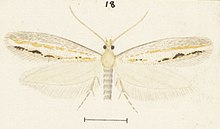Sagephora exsanguis
| Sagephora exsanguis | |
|---|---|

| |
| Scientific classification | |
| Domain: | Eukaryota |
| Kingdom: | Animalia |
| Phylum: | Arthropoda |
| Class: | Insecta |
| Order: | Lepidoptera |
| Family: | Tineidae |
| Genus: | Sagephora |
| Species: | S. exsanguis
|
| Binomial name | |
| Sagephora exsanguis | |
Sagephora exsanguis is a species of moth in the family Tineidae.[2][1] It was described by Alfred Philpott in 1918. This species is endemic to New Zealand and has been found on Cuvier Island, as well as the North and South Islands. The adults of this species are on the wing from October to December.
Taxonomy
[edit]
This species was first described by Alfred Philpott in 1918, using specimens collected in Bluff and Dunedin in October, November and December, and named Sagephora exsanguis.[3] In 1928 George Hudson described and illustrated this species in his publication The butterflies and moths of New Zealand.[4] The male holotype specimen, collected in Bluff, is held at the New Zealand Arthropod Collection.[5][6]
Description
[edit]
Philpott described this species as follows:
♂. 10-12 mm. Head white, face ochreous. Palpi white, apical half of second joint brown. Antennae, thorax, and abdomen white. Forewings elongate, narrow, costa moderately arched, apex round-pointed, termen rounded, extremely oblique ; white ; costa and dorsum broadly pale-brownish throughout reducing ground-colour to a median stripe ; apical half of dorsal stripe irregularly margined above with blackish ; a few dark scales on costa near apex : cilia concolorous with wing - markings. Hindwings and cilia shining white.[3]
Distribution
[edit]This species is endemic to New Zealand and has been collected on the South, North and Cuvier Islands.[2][6]
Habitat
[edit]This species inhabits native forest as well as wetlands.[4][7]
Behaviour
[edit]The adults of this species are on the wing from October until December.[4]
Hosts
[edit]This species is associated with Carex species found in wetlands.[7]
References
[edit]- ^ a b "Sagephora exsanguis Philpott, 1918". www.nzor.org.nz. Landcare Research New Zealand. Retrieved 15 February 2018.
- ^ a b Gordon, Dennis P., ed. (2010). New Zealand inventory of biodiversity: Kingdom animalia: chaetognatha, ecdysozoa, ichnofossils. Vol. 2. p. 464. ISBN 978-1-877257-93-3. OCLC 973607714. OL 25288394M. Wikidata Q45922947.
- ^ a b Alfred Philpott (1918). "Descriptions of new species of Lepidoptera". Transactions and Proceedings of the New Zealand Institute (in English and English). 50: 131. ISSN 1176-6158. Wikidata Q110875537.
- ^ a b c George Vernon Hudson (1928), The butterflies and moths of New Zealand, Illustrator: George Hudson, Wellington: Ferguson and Osborn Limited, p. 342, LCCN 88133764, OCLC 25449322, Wikidata Q58593286
- ^ John Stewart Dugdale (23 September 1988). "Lepidoptera - annotated catalogue, and keys to family-group taxa". Fauna of New Zealand. 14. Department of Scientific and Industrial Research: 64. doi:10.7931/J2/FNZ.14. ISSN 0111-5383. Wikidata Q45083134.
- ^ a b "Sagephora exsanguis Philpott, 1918". www.gbif.org. Retrieved 2022-02-10.
- ^ a b Brian H. Patrick (1997). "Codfish Island moths" (PDF). The Wētā. 20: 17–20. ISSN 0111-7696. Wikidata Q110875754. Archived from the original (PDF) on 18 October 2008.
